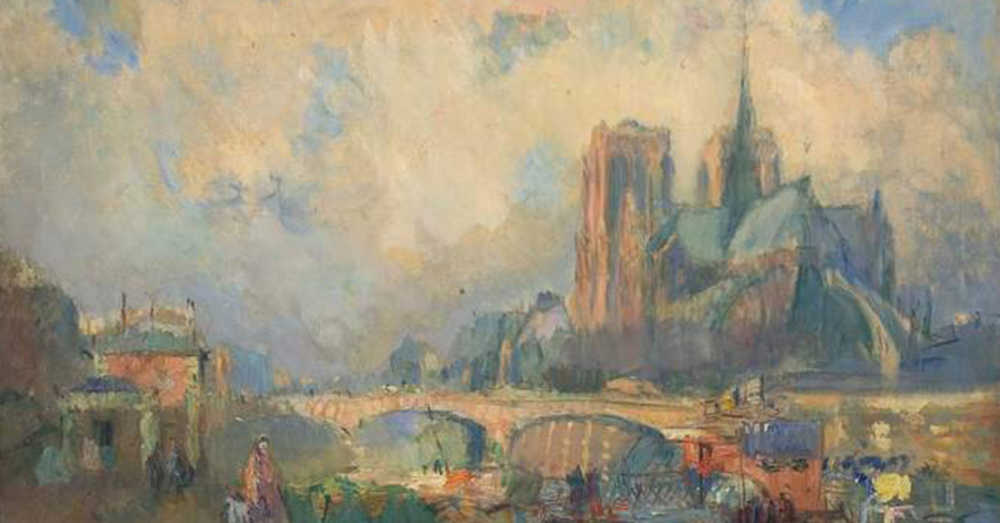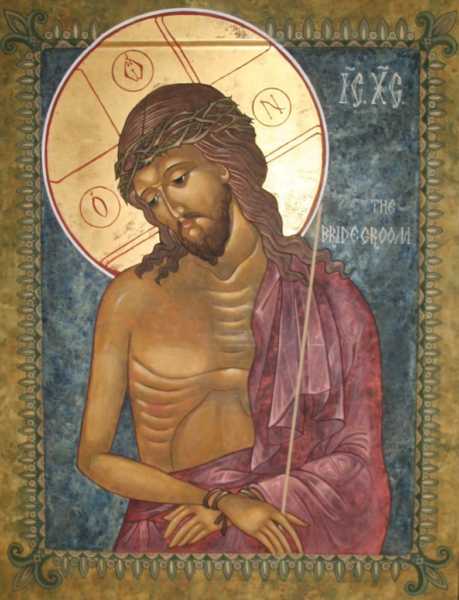We run our website the way we wished the whole internet worked: we provide high quality original content with no ads. We are funded solely by your direct support. Please consider supporting this project.

Notre Dame and Why Beauty Matters
Article by Jordan Sutton, from the Holy Week Art Series at ClearPath.Life
“Is Paris burning?”
That is a direct quote from Adolf Hitler in 1944 on a phone call with his general, Dietrich Hugo Hermann von Choltitz, who oversaw the Nazi occupation of Paris.
Hitler had given his highly decorated general orders to “level” the city of Paris. At the time, Von Choltitz had headquartered his operation at the iconic Hotel Le Meurice which sits on the Jardin des Tuileries. He had been overcome by the beauty, history and culture of Paris and so disobeyed the orders of “The Fuhrer.” Beauty is a force of nature that we can’t fully describe.
Hitler’s question inspired the famed 1966 French film, “Is Paris Burning?”
Those words came to mind as I turned on the news yesterday to see that Notre Dame was in flames.
Some years ago, my wife and I had the great privilege to sit in Sunday mass at the Notre Dame. It’s hard to describe the uniqueness and beauty of this iconic place of worship. It sits on an island in the middle of the Seine River, as a relic of faith, the heartbeat of one of the world’s most progressive and diverse cities.
The Notre Dame has been around for roughly 850 years since construction began and has survived its desecration in the French Revolution and restoration in the middle of the 19th century.
When I saw the burning of its roof, my heart sank. Part of me was wondering why I was so moved. Should I be so moved? There are countless human crises going on around the world that rightfully deserve a deeper churning in my soul than the devastation of a building, whether old or new, plain or immaculate. But I couldn’t shake it; I was moved, nonetheless, as it seems were a host others.
And it kind of begs the question: Why? Why has this place lasted so long? Why are we so moved by the flames filling its walls?
Beauty is likely one of the most underestimated elements of profound importance both in life and in the scriptures. We sing of the beauty of God, the vastness of His love, the majesty of His creative imagination seen in nature, but it seems in our teaching and theology, beauty misses the place of emphasis it deserves.
There was a day in time where art was one of the primary ways the gospel was understood, transmitted, imparted and preserved for people everywhere. People who couldn’t read and didn’t have access to the scriptures would see and remember the great story of the gospel in countless stained glasses pieces, ceiling murals, frescos, statues and other art pieces.
Thankfully after the invention of the printing press and the fruit of the Reformation in the 16th century, people everywhere began interacting with the scriptures for themselves and in their own language. The last 500 years of church evolution have evidenced a more informed and involved church, where all those seeking to more deeply know and express truth in their lives read and study the scriptures, not just those in so-called clergy.
But maybe in this movement toward greater understanding, there is a value that we have overlooked. Maybe we have overestimated figuring it all out and underestimated being captured in wonder.
We often have Bible studies to flesh through the finer points of specific doctrinal truths, but how often do we just read the scripture and smile, breathe deep, sit in silence and awe? How often do we look out an intricate design of a tree or plant and think, wow, God is truly amazing? How often do we gaze upon a piece of art, old or modern, that depicts some element of love, some truth of the gospel and instead of figuring out, just receive?
Receive the beauty of his kingdom.

Consider the piece “Christ our Bridegroom.”
While there is much symbolism in the piece, “Christ our Bridegroom,” the most moving element to me is the gaze of Christ as he awaits his bride. The painting depicts the imagined anticipation of one awaiting, pondering, praying over the time he would be united with his lover.
Solomon beautifully depicts the potency of this union between two lovers, between a bride and her bridegroom, in his opening remarks of the Song of Songs.
Let him kiss me with the kisses of his mouth—for your love is more delightful than wine. Pleasing is the fragrance of your perfumes; your name is like perfume poured out. – Song of Solomon 1:2-3
Jesus is not merely an “icon” or a model of what it means to be good. Jesus is the lover of our souls who woos and waits on us as we persevere in this life under the sheltering of his grace. The union we experience is real and life-giving, but we hope for a deeper connection, a fuller experience of the one who loves us. We are awaiting being fully united with our bridegroom.
The beauty of this piece reminds of that. The beauty of knowing the very reality that he is awaiting us ministers to our souls. It speaks to a place that no principle can.
I can’t give you a 21-part explanation of how Christ is our bridegroom, but I am overwhelmed that the creator of the universe loves us so deeply that he waits for us, weeps for us and is moved by us.
This kind of beauty is at the heart of the gospel. It is at the heart of what it means to be a Christian. It is at the heart of His kingdom coming to earth as it is in heaven.
Jesus didn’t bring redemption to humanity and the entirety of the cosmos through a 4-part sermon or a well-written position paper; He did it through an act…the act of all acts. He stepped into both death and resurrection. And by His bodily death and resurrection, we are drawn by His spirit into the depths of himself and made alive in him.
Wow, what beauty. A beauty that saved the world. [Check our Brian Zahnd’s book Beauty Will Save the World.]
Now as I consider our present situation, the burning of this old cathedral, I recognize that in the end, all will be dust and ash before Him, but maybe, just maybe, there can be a beautiful story that comes from the ashes contained in those walls. Maybe the greatest passion week story that has ever been told by this relic of artistic beauty can still be told.
God is indeed a God of resurrection. And for there to be a resurrection, there must be death.
Isaiah 61 describes God’s beautiful good news for those who have been broken. Let us ponder on these words as we consider Jesus’ great and beautiful sacrifice for us.
The Spirit of the Sovereign Lord is on me,
because the Lord has anointed me
to proclaim good news to the poor.
He has sent me to bind up the brokenhearted,
to proclaim freedom for the captives
and release from darkness for the prisoners,to proclaim the year of the Lord’s favor
and the day of vengeance of our God,
to comfort all who mourn,and provide for those who grieve in Zion—
to bestow on them a crown of beautyinstead of ashes,
the oil of joy
instead of mourning,
and a garment of praise
instead of a spirit of despair.
They will be called oaks of righteousness,
a planting of the Lord
for the display of his splendor.They will rebuild the ancient ruins
and restore the places long devastated;
they will renew the ruined cities
that have been devastated for generations.
And may God raise up the ruins of the beautiful Notre Dame, not as a testimony of the human spirit, but as a reminder of the one who through wisdom laid the foundations of heaven and earth.
____ ____ ____
art: “Paris, the Archbishop’s Bridge and Notre-Dame seen from the Quai de la Tournelle”
by: Albert Lebourg
date: c.1890
Category: General, Guest Contributor
Tags: Art, Beauty, Social Issues
Guest Contributor:

Jordan Sutton is the lead pastor of Clearpath Dallas, a collective of house churches in Dallas, TX. He and his wife, Andrea, are directors of an online magazine, Clearpath.Life, where readers can experience the beauty of the Jesus life. They reside in Dallas with their 3 kids, Grace, Eden and Judah.
Related Reading

homosexuality, truth telling, and love
A Guy Taking Pictures via Compfight A couple weeks ago, we posted a portion of Greg’s sermon (and his comments) on the marriage amendment in Minnesota, homosexuality and finding a “Third Way”. Today we’re continuing the conversation by linking to a blog post by Sarah Bessey called In which I tell you the truth about…

In your Anabaptist view, should Christians get involved in politics at all? Do you think they should even vote?
Ultimately, each person must follow their conscience when it comes to whether or not they vote, how they vote if they decide to vote, and the extent to which they should involve themselves in the political system. But we must always remain aware of the dangers involved in participating in the political system, for it…

Shouldn’t preachers rally Christians to fight political injustice?
Question: My pastor has publicly supported your book The Myth of a Christian Nation. But he’s recently called on the church to take a stand against the injustice of our local government cutting funding for inner city recreational facilities. This seems right to me, since we’re suppose to defend the cause of the poor and…

The Life and Death of MLK and What it Might Have to Say to Us
Tony Fischer via Compfight Here is an EXCELLENT reflection from Jonathan Martin in answer to a question that was posed to him on how he reconciles his rejection of the politics of this world with the social justice work of MLK. This is a must read. From the article: So to come to the question,…

Do Something Beautiful
Wonderlane via Compfight Richard Beck posted this reflection of the woman who anointed Jesus’ feet with her hair and the idea of a Christian aesthetic. It’s inspiring. From the blog: More and more, I’ve come to describe my faith in similar terms, in aesthetic terms. Some things in the world–big global things and small things I…

Does the Bible forbid interracial marriages?
Absolutely not! Racist Christians used to argue against interracial marriage by quoting Old Testament passages that prohibited Jews from marrying non-Jews. This prohibition had nothing to do with race, however. In fact, there was no concept of different “races” until white Europeans invented it during the Colonial period, partly to justify their enslavement of other…
